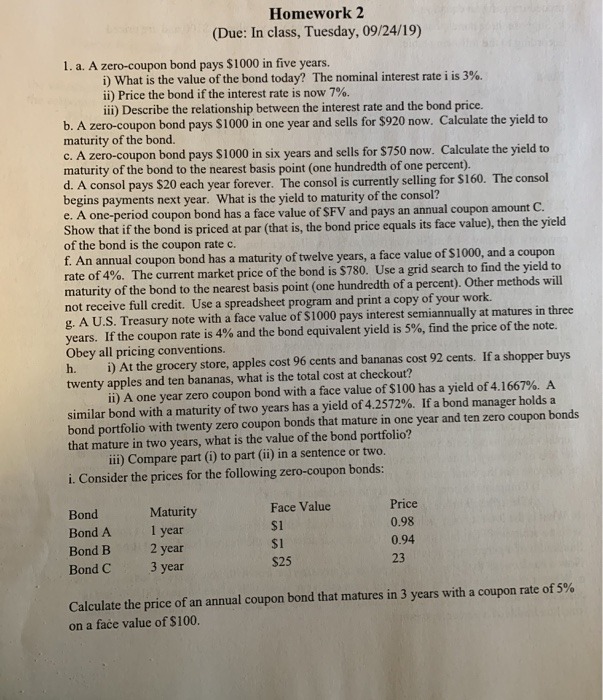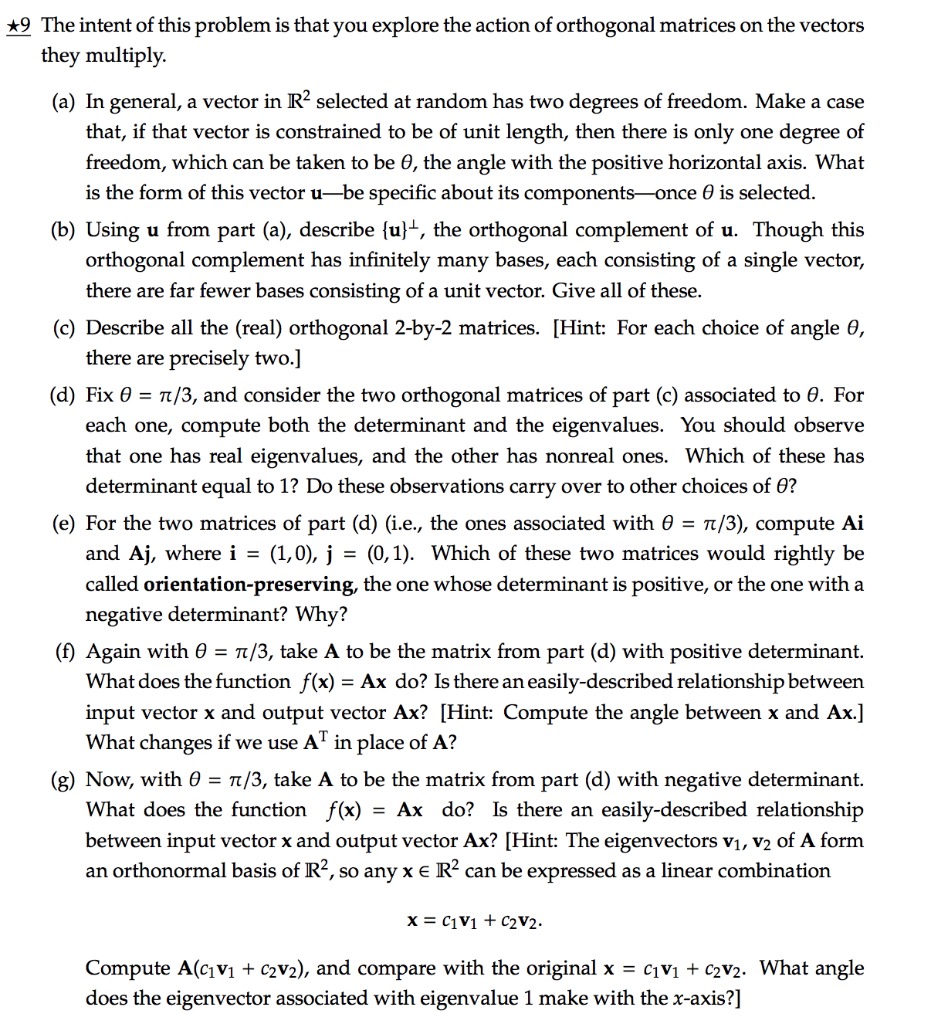


.Please include workings
Homework 2 (Due: In class, Tuesday, 09/24/19) 1. a. A zero-coupon bond pays $1000 in five years. i) What is the value of the bond today? The nominal interest rate i is 3%. ii) Price the bond if the interest rate is now 7%. ili) Describe the relationship between the interest rate and the bond price. b. A zero-coupon bond pays $1000 in one year and sells for $920 now. Calculate the yield to maturity of the bond. c. A zero-coupon bond pays $1000 in six years and sells for $750 now. Calculate the yield to maturity of the bond to the nearest basis point (one hundredth of one percent). d. A consol pays $20 each year forever. The consol is currently selling for $160. The consol begins payments next year. What is the yield to maturity of the consol? e. A one-period coupon bond has a face value of SFV and pays an annual coupon amount C. Show that if the bond is priced at par (that is, the bond price equals its face value), then the yield of the bond is the coupon rate c. f. An annual coupon bond has a maturity of twelve years, a face value of $1000, and a coupon rate of 4%. The current market price of the bond is $780. Use a grid search to find the yield to maturity of the bond to the nearest basis point (one hundredth of a percent). Other methods will not receive full credit. Use a spreadsheet program and print a copy of your work. g. A U.S. Treasury note with a face value of $1000 pays interest semiannually at matures in three years. If the coupon rate is 4% and the bond equivalent yield is 5%, find the price of the note. Obey all pricing conventions. h. i) At the grocery store, apples cost 96 cents and bananas cost 92 cents. If a shopper buys twenty apples and ten bananas, what is the total cost at checkout? ii) A one year zero coupon bond with a face value of $100 has a yield of 4.1667%. A similar bond with a maturity of two years has a yield of 4.2572%. If a bond manager holds a bond portfolio with twenty zero coupon bonds that mature in one year and ten zero coupon bonds that mature in two years, what is the value of the bond portfolio? iii) Compare part (i) to part (ii) in a sentence or two. i. Consider the prices for the following zero-coupon bonds: Bond Maturity Face Value Price Bond A 1 year $1 0.98 Bond B 2 year $1 0.94 Bond C 3 year $25 23 Calculate the price of an annual coupon bond that matures in 3 years with a coupon rate of 5% on a face value of $100.*_9 The intent of this problem is that you explore the action of orthogonal matrices on the vectors the}r multiply. (a) In general, a vector in R2 selected at random has two degrees of freedom. Make a case that, if that vector is constrained to be of unit length, then there is only one degree of freedom, which can be taken to be 6, the angle with the positive horizontal axis. What is the form of this vector ube specic about its componentsonce 6 is selected. (b) Using u from part (a), describe [ul the orthogonal complement of 11. Though this orthogonal complement has infinitel}r many bases, each consisting of a single vector, there are far fewer bases consisting of a unit vector. Give all of these. (c) Describe all the (real) orthogonal 2-by2 matrices. [Hintz For each choice of angle 9, there are precisely two.] (d) Fix 6 = f3, and consider the two orthogonal matrices of part (c) associated to 6. For each one, compute both the determinant and the eigenvalues. You should observe that one has real eigenvalues, and the other has nonreal ones. Which of these has determinant equal to 1? Do these observations carry over to other choices of 6? (e) For the two matrices of part (d) tie, the ones associated with 6 = HIS), compute Ai and Aj, where i = (1,0), j = (0,1). Which of these two matrices would rightly be called orientation-preserving, the one whose determinant is positive, or the one with a negative determinant? My? (f) Again with 6 = 11/3, take A to be the matrix from part (d) with positive determinant. What does the function x) = A): do? Is thereaneasily-described relationship between input vector x and output vector Ax? [I-Iint: Compute the angle between x and Ax] What changes if we use AT in place of A? (g) Now, with 9 = 1r! 3, take A to be the matrix from part (:1) with negative determinant. What does the function f(x) = Ax do? Is there an easily-described relationship between input vector x and output vector Ax? [Hint The eigenvectors v1, V2 of A form an orthonormal basis of IRZ, so any x E R2 can be expressed as a linear combination X = $1171 + C2V2. Compute A(c1v1 + czvz), and compare with the original 1: = clvl + czvz. What angle does the eigenvector associated with eigenvalue 1 make with the x-axis?] Question 3 Emma is a first-year Ph.D. student of economics. She is very lucky because she got a place to stay in the Aggie Village, the nicest part of Davis. She lives in a beautiful cottage with a little garden. Her modest wealth from being a TA is w. She spends it on coffee and gardening. Let z, denote the amount of coffee and ro the amount of gardening and let p, and p, denote the corresponding unit prices. Her budget constraint is given by Pili + patz w. (1) Coffee is really a private good in the sense that she is the sole beneficiary of caffeine in her coffee (unless she calls up in panic her fellow student in the middle of the night because she cannot solve her ECN200A homework problem). In contrast, gardening creates a positive externality on others. But so does the gardening of others create a positive externality on her. There is plenty of gardening in the Aggie Village. Denote by e the total externality or public good created from gardening in the community. Her utility function u(11, 12, e) is concave and continuously differentiable with a strictly positive gradient on the interior of its domain. The total externality depends in part on Emma's gardening r2 and on the externality created by the gardening of others, denoted by e-;. It is assumed to satisfy ese-ito12 (2) for some parameter a satisfying o > 0. Emma does not think that she can affect the level of externalities provided by others. For instance, Professor Schipper, who also lives in the Aggie Village, is so busy writing prelim exam questions that talking to him about keeping up his gardening is no use. Thus, we can safely assume that Emma takes e_; as well as p1. p2, and w as given. Since Emma diligently studies microeconomic theory for the prelims, she is eager to maximize her utility function subject to constraints (1) and (2). This yields demand functions I,(p1, paw, e_;) and 12(p1, P2, w, e_;) as well as her optimal desired amount of public good e(P1 , P2, w, e-;). a.) Write down her Kuhn-Tucker-Lagrangian (ignore non-negativity constraints). b.) Derive the Kuhn-Tucker first-order conditions (ignore non-negativity constraints). c.) Use the Kuhn-Tucker conditions and the assumptions that the solution is interior, that it is unique, and that constraints (1) and (2) are satisfied with equality to derive a system of three equations and three unknowns that does not involve multipliers and whose solution defines ri(p1, pz, w, e-;), 2(p1, p2, w, e_.) and e(p1, p2, w, e-;). (No need to solve it.) d.) If you think that Professor Schipper acts in a strange way sometimes, this is not just due to being an economic theorist. The secret is he comes from another












